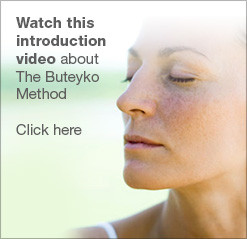Teaching Asia to Breathe
Thailand Indochina Traveller August 1999 issue
Asia’s cities are choking their inhabitants – and visitors – but you don’t need a face mask or ventilator to cope with the allergies, asthma and smog. Don Schultz tries the revolutionary Buteyko breathing technique as it becomes available in Southeast Asia.
Even cosmonauts do Buteyko.
In Bangkok, it’s not unheard of to see a Thai with a decongestant inhaler kept up one nostril. As asthma cases rocket, allergies mount, and chronic fatigue sets in, emergency puffers like Ventalin, Theofalin and Bricanol are used at the slightest discomfort. Ironically, an asthma attack is the body desperately trying to breathe LESS. Like anti-biotics, bronchodilators over-ride your natural defences! “The primary reason for over-breathing seems to be stress without corresponding physical action, plus inappropriate diet, sedentary lifestyles, bad posture, pollution, etc,” explains Jac Vidgen, a Bangkok-based Buteyko breathing practitioner currently touring Southeast Asia. Apparently, it’s not only asthma sufferers who hyperventilate; we all do. That sounds like heresy, when received wisdom is that deep breathing is good. In fact, it’s controlled shallow breathing that enables high performance of your body and mind. Ask any yogi.
Problem is, breathing is the only automatic bodily function we can change, so bad habits ratchet up the rate we inhale. By reversing that trend, Buteyko exercises stop us exhaling too much carbon dioxide, which isn’t a waste product, but a maligned gas we make in order to improve oxygenation of the blood and relax the smooth muscles in our organs. If you’ve a stressed-out heart, liver or digestive system, you can imagine how much more efficiently, and comfortably, your body could function if you simply breathed correctly. “More than 90% of people with asthma or respiratory problems achieve considerable improvement – often within a few days,” says Jac. “In the Queensland trial, asthmatics reduced reliever medication by 96% and preventer medication by 50% at 3 months with reduced symptoms [Medical Journal of Australia, Dec.1998].” Given that breathing is the most important bodily function, it’s amazing that doctors almost never consider it, let alone measure it. Instead, preventative allopathic medicine concentrates on less critical factors like diet, exercise, sleep, stress, fluid intake – and drug prescription.
Actually there is an agreed measure for breathing, but if heart rate, blood cholesterol or uric acid were reading 4-6 times normal you’d be more than worried. Yet mass hyperventilation was routinely overlooked until Dr Konstantine Buteyko’s 30 years of observations and tests led to his theories being adopted by Russia’s health service in 1982. Even cosmonauts do Buteyko. Still unconvinced? If you breathe imperceptibly through just your nose, something astonishing happens – your bronchial tubes enlarge naturally. “I’ve had three colds in the year since I learned Buteyko and never once has my nose been blocked,” says Phil Cornwel-Smith, editor of Bangkok Metro Magazine. “It also stops sneezing, gets rid of headaches, reduces my appetite, keeps me slimmer, shortens sleep, calms my mood…” It can also cause traces of past illness to resurface before dissipating for good, which is one reason a practitioner’s vital. Plus you simply can’t correct faults that feel “right” from a book or video. Philip learned Buteyko because of allergies, but it also revealed muscle trauma from computer work. “I couldn’t believe it when I learned that in the room during my fifth Buteyko class there was a cat. Previously my eyes and nose would’ve been streaming, but now not even a sniffle,” he says. “It’s liberating. In heavy traffic everyone else is choking while I let my nose gently filter out the fumes.
It’s incredible how I notice heavy mouth-breathers have so much else wrong with them.” Jac is well armed about the dangers of using the mouth to breathe. “The nose not only filters, but also humidifies, adjusts the temperature and regulates the flow (in and out) – essential roles when you’re exposing about a football field of your tissue to the outside air 30,000 times a day.” Interestingly, we’re most vulnerable to this while asleep and should rest on our left side. The list of ailments alleviated by Buteyko is astonishing – sinusitis, sleep apnoeia, psoriasis, immune deficiencies, angina, haemorrhoids, varicose veins, cancer, and even snoring – but disputed by status-aware doctors and a pharmaceutical industry that’s funded by dependency drugs like anti-histamines. “Every medical advance faces resistance, but I sense Buteyko’s going to be a biggie,” says chiropractor Dr Leon W James of East-West Healing Concepts in Bangkok, who notes how doctors were dismissive of chriopractic’s results until proven wrong in court.
“It’s good that Buteyko’s already had laboratory trials, but it needs many more of them.” Patients are, however, more receptive than ever to holistic treatments. “Buteyko reaches all the body’s systems through the circulation,” says Dr James. “Like chiropractic, it seems to unlock healing forces through a non-drug and non-surgical approach that gives you personal control.” Ultimately, Buteyko isn’t about treating problems, but preventing them. Interestingly, the asthmatic children in Jac’s classes often have less complicated health issues than their unawares parents. If you can discipline yourself to the five-day course, Jac claims, “You’ve got a preventative tool for life.”
Copyright 1999 by Thailand Indochina Traveller Magazine.
